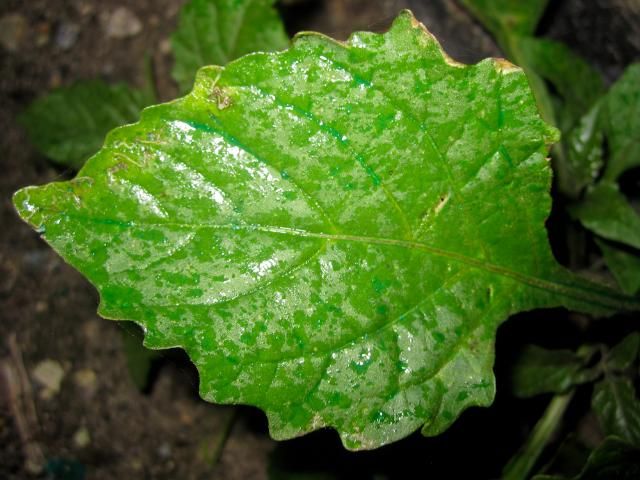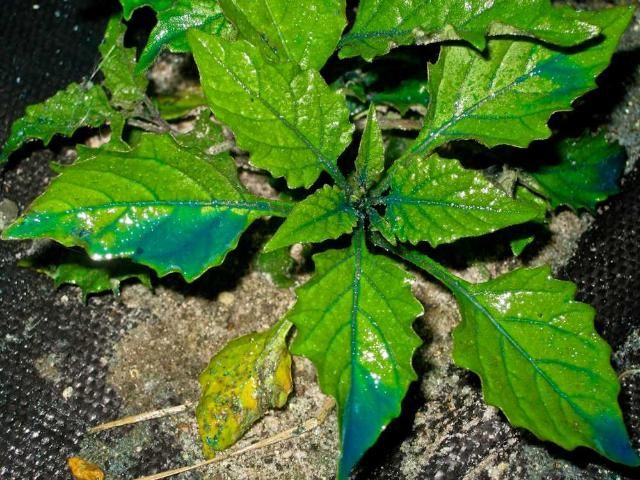Glyphosate is the largest-selling single crop protection chemical worldwide (Woodburn 2000) and the most used herbicide in the nursery industry in the United States (Norcini et al. 1996). It is used for postemergent control of vegetation. Glyphosate is an extremely effective chemical that controls a broad spectrum of annual and perennial grasses, broadleaves, and sedges. This herbicide acts as an inhibitor of an enzyme that leads to the formation of several essential amino acids required for normal protein synthesis. Glyphosate has the ability to spread throughout the plant and concentrate in the growing regions where these amino acids are most needed for new growth. As a nonselective, translocating herbicide, it is easy to cause unintended damage to desirable vegetation if this product is used incorrectly. This publication outlines the proper use of glyphosate for plant producers and their employees.
As with any herbicide, glyphosate should not be overused and should be one of several components of an integrated weed management program. In addition to chemical control, growers should employ biological, mechanical, and cultural weed control techniques. In the case of glyphosate, its general overuse and the common practice of using it alone (hence only a single mechanism of weed control action) have resulted in the selection for an increasing number of glyphosate-resistant weed populations (Owen and Zelaya 2005). In addition, the improper use of glyphosate has resulted in weed population shifts where glyphosate-tolerant weeds predominate. An increasing number of glyphosate-tolerant and resistant weeds are emerging (Beckie 2011), some of which are showing up in plant nurseries. (See Biology and Management of Ragweed Parthenium (Parthenium hysterophorous L.) in Ornamental Crop Production) [https://edis.ifas.ufl.edu/publication/EP531], Prevention, Early Detection, and Eradication of Benghal Dayflower in Field Nurseries [https://edis.ifas.ufl.edu/ep350], Biology and Management of Liverwort (Marchantia polymorphia) in Ornamental Crop Production [https://edis.ifas.ufl.edu/ep542], and Biology and Management of Pilea microphylla (Artillery Weed) in Ornamental Crop Production [https://edis.ifas.ufl.edu/ep535] for more information.) Therefore, it is recommended that, whenever possible and appropriate, glyphosate be used along with residual herbicides with overlapping efficacy of control of the target weeds. This will result in better, longer-term control and lengthen the time before additional herbicide applications might be needed.
Before using any herbicide (or other pesticide), the entire label should be read and understood. Remember: The label is the law!
Step 1: Identify the Weed Species
The first step toward proper application is to identify the weed species that must be controlled. Identification may be accomplished using guides, such as Weeds of Southern Turfgrass by T. R. Murphy et al., available in the UF digital library (https://ufdc.ufl.edu/aa00091867/00001), or weed samples may be taken to your local Extension office for help with identification. Weed samples should include as many parts of the plants as possible, especially reproductive structures like flowers or seeds.
Step 2: Read and Follow Label Instructions
Correctly identifying the weed species allows the applicator to determine the amount of glyphosate product to be mixed in a spray tank to obtain the recommended concentration for the target weeds. Follow the label closely and adhere to the warnings that are mentioned, especially those regarding proper application listed under "General Information" on the label. These can be summarized in the following list:
- Never mix glyphosate in galvanized steel or unlined steel container spray tanks. Doing so can cause a highly combustible hydrogen gas to form and may result in metal corrosion if left in contact for a period of time.
- Glyphosate can be washed off with either rain or irrigation water for a period of time after application. Check the label of the glyphosate formulation for that critical time period.
- Glyphosate is rapidly inactivated once in the soil. Weed seeds that germinate after application will not be controlled.
- Annual weeds are harder to control the larger they grow and when they are stressed. They should be treated before they start to develop reproductive organs (cones, flowers, etc.).
- Glyphosate may not translocate well when weeds are not growing, and reduced control may result when the weeds have been cut recently or if there are drought conditions.
- Visible symptoms of the herbicide's effects may take days to develop, especially in cold or cloudy conditions.
- Do not let glyphosate-containing spray contact the foliage or green bark of desirable plants. Glyphosate should also not be allowed to come in contact with thin-barked plants.
Applicators and handlers must wear long-sleeved shirts, long pants, shoes, and socks. Although not mandatory on the label, it is a good practice to wear chemical-resistant (e.g., butyl rubber, polyvinyl chloride) gloves when mixing and spraying glyphosate (Monsanto 2006) because a sprayer may clog, a leak may develop, or the applicator's hands may come in contact with the herbicide. Hands and forearms are the most common place of contact for mixers and handlers. Always remember that anyone who is applying or handling glyphosate is considered a handler under the Worker Protection Standard Act. (For more information on the Worker Protection Standard, visit https://edis.ifas.ufl.edu/topic_wps.) Even a person who merely picks up an opened jug of herbicide to move it around on the farm is considered a handler and must be trained as a handler. Also, waterproof gloves are required for early entry into glyphosate-treated areas if contact is anticipated with anything that has been sprayed.
Step 3: Properly Calibrate Spray Equipment
The next step is to properly calibrate spray equipment before making an application. The applicator must know what type of sprayer will be used and how much liquid is being applied over a certain amount of area. For help on this topic, please refer to Calibration (https://edis.ifas.ufl.edu/topics/calibration). Glyphosate sprays can be applied over a range of concentrations depending on the weed growth stage and species and the ability to obtain coverage with the spray. Check the product label for specific recommendations. For most of the weeds typically found around nurseries, 1%–2% solutions (volume glyphosate product/volume of water) are usually effective. However, if hard water (containing the cations calcium and magnesium) is used to make up the spray solution, some of the glyphosate may be bound up, thereby decreasing the spray's efficacy. This antagonism can be overcome by dissolving ammonium sulfate (AMS) in the water before adding the glyphosate (Peterson and Thompson 2009). The recommended rate of dry AMS is 1%–2% (weight of AMS/weight of solution). An equivalent rate of a liquid formulation of AMS may also be used. Other adjuvants (inert ingredients), such as urea (Li et al. 2012) and commercially formulated products, can also be used to counter the effects of hard water. Further, be aware that different commercial glyphosate formulations contain different adjuvants and can vary in efficacy (Chikoye, Lum, and Udensi 2010).
Step 4: Apply Solution
When the appropriate application concentration is determined and thoroughly mixed, the solution can then be applied. For the best results, apply to dry weed foliage. Spray coverage should be uniform, complete, and made on a spray-to-wet basis, meaning the leaf surface should have a misted, wet appearance (Figure 1). It is very important to remember that glyphosate translocates. Overapplication is one of the most common errors found with the application of glyphosate. There is no need to spray weeds to the point of runoff or until they are dripping wet (Figure 2). Further, if the glyphosate solution enters the soil or is sprayed around nursery containers, it could injure soil organisms by direct contact and non-target plants through root uptake before inactivation can occur. In addition, overapplying glyphosate is a significant waste of time and money. Using a temporary dye in the spray solution can help applicators check spray uniformity and keep track of what weeds have been treated (Figures 1 and 2). The dye also helps to avoid skips and oversprays.

Credit: S. Steed, UF/IFAS

Credit: S. Steed, UF/IFAS
Apply glyphosate solution to the target weeds only. Never spray in high wind conditions or at times when there might be temperature inversions. Temperature inversions are when temperatures are warmer at higher altitudes than on the ground. They are associated with limited cloud cover and wind. They also may be characterized by the presence of ground fog or smoke that moves horizontally rather than vertically. Avoid overspray or drift particles that may contact any desirable plants in the nursery. If the herbicide drifts and contacts green leaves, shoots, or surface roots of desirable plants, they will be negatively affected by the herbicide. The potential for drift can be reduced by using spray nozzles designed to reduce the production of fine spray droplets and by avoiding the use of high sprayer pressures. Sprayer shields and hoods (Figure 3) can work well in nursery production settings to minimize the potential of drift onto saleable inventory.

Credit: S. Steed, UF/IFAS
Be aware that glyphosate can wash off of inorganic materials like gravel and plastic weed control fabrics (Grey et al. 2009). If that wash-off water comes in contact with the roots of plants, damage may occur. Likewise, it is reported that glyphosate can bind to bark used in potting mixes and be released when the containers are irrigated. Therefore, use means other than herbicides to keep stored growing media weed free.
Sprayers used to apply glyphosate and/or other herbicides should be dedicated for applying herbicides only and not used to spray crops with other materials, such as fungicides or insecticides. If the sprayer must be used to apply materials to desirable plants, it must be cleaned out immediately after being used to apply glyphosate. Spray as much of the glyphosate solution out of the spray tank as possible, then rinse the tank with clean water. Refill the tank and spray clean water through the hose and nozzle. Running a cleaning solution of 1%–2% (volume/volume) ammonia in water through the system followed by a second clean water rinse finishes the cleaning process. Be careful not to dispose of the water used in cleaning anywhere where it could damage plants or cause environmental harm.
Summary
The effectiveness of glyphosate can be ensured by following the herbicide label and applying the product in the proper manner and quantities. Following proper application procedures reduces the amount of non-target damage caused by drift occurrences and saves time, labor, and money incurred by unproductive, wasteful applications.
Literature Cited
Beckie, H. J. 2011. "Herbicide-Resistant Weed Management: Focus on Glyphosate." Pest Management Science 67 (9):1037–1048.
Chikoye, D., A. F. Lum, and U. E. Udensi. 2010. "Efficacy of a New Glyphosate Formulation for Weed Control in Maize in Southwest Nigeria." Crop Protection 29 (9):947–952.
Grey, T. L., W. K. Vencill, T. M. Webster, and A. S. Culpepper. 2009. "Herbicide Dissipation from Low Density Polyethylene Mulch." Weed Science 57 (3):351–356.
Li, P. L., S. He, T. Tang, K. Qian, H. W. Ni, and Y. S. Cao. 2012. "Evaluation of the Efficacy of Glyphosate Plus Urea Phosphate in the Greenhouse and the Field." Pest Management Science 68 (2):170–177.
Monsanto. 2006. "Roundup Original MAX® Herbicide Material Safety Data Sheet." Monsanto Company.
Norcini, J., M. Garber, W. Hudson, R. Jones, A. Chase, and K. Bondari. 1996. "Pest Management in the United States Greenhouse and Nursery Industry: IV. Weed Control." HortTechnology 6 (3):211–216.
Owen, M. D. K., and I. A. Zelaya. 2005. "Herbicide-Resistant Crops and Weed Resistance to Herbicides." Pest Management Science 61(3):301–311.
Peterson, D., and C. Thompson. 2009. "Glyphosate Weed Control Enhancement with Ammonium Sulfate and Commercial Water Conditioning Agents." Journal of ASTM International (JAI) 6 (5):JAI102147.
Woodburn, A. T. 2000. "Glyphosate: Production, Pricing and Use Worldwide." Pest Management Science 56 (4):309–312.